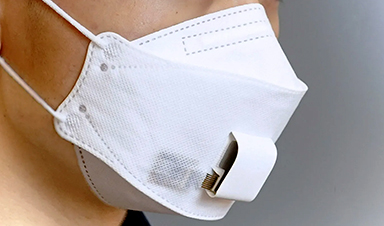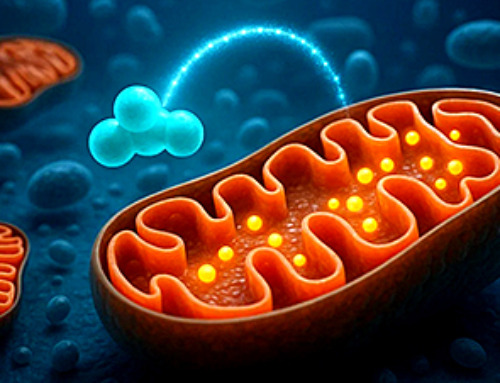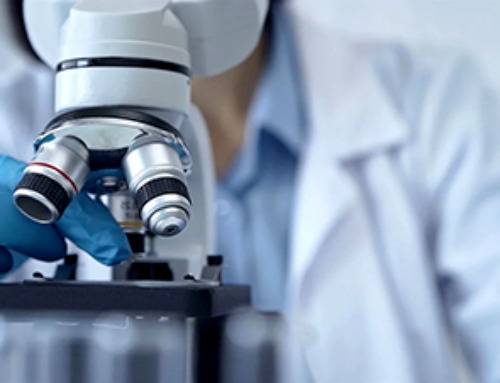Your breath can give away a lot about you. Each exhalation contains all sorts of compounds, including possible biomarkers for disease or lung conditions, that could give doctors a valuable insight into your health.
Now a new smart mask, developed by a team at the California Institute of Technology, could help doctors check your breath for these signals continuously and in a noninvasive way. A patient could wear the mask at home, measure their own levels, and then go to the doctor if a flare-up is likely.
“They don’t have to come to the clinic to assess their inflammation level,” says Wei Gao, professor of Medical Engineering at Caltech and one of the smart mask’s creators. “This can be lifesaving.”
The smart mask, details of which were published in Science today, uses a two-part cooling system to chill the breath of its wearer. The cooling turns the breath into exhaled breath condensate (EBC).
EBC, essentially a liquid version of someone’s breath, is easier to analyze, because biomarkers like nitrite and alcohol content are more concentrated in a liquid than in a gas. The mask design takes inspiration from plants’ capillary abilities, using a series of microfluidic modules that create pressure to push the EBC fluid around to sensors in the mask.
The sensors are connected via Bluetooth to a device like a phone, where the patient has access to real-time health readings.
“The biggest challenge has always been collecting real-time samples. This problem has been solved. That’s a paradigm shift,” says Rajan Chakrabarty, professor of Environmental and Chemical Engineering at Washington University in St. Louis and who was not involved in the research.
The Caltech team tested the smart mask with patients, including several who had chronic obstructive pulmonary disease (COPD) or asthma or had just gotten over a covid-19 infection. They were testing the masks for comfort and breathability, but they also wanted to see if the masks actually worked at tracking useful biomarkers throughout a patient’s daily activities, such as exercise and work.
The mask picked up on higher levels of nitrite in patients who had asthma or other conditions that involved inflamed airways. It also picked up on higher alcohol content after a patient went out drinking, which demonstrates another potential application of the mask. Analyzing breath this way is more accurate than the typical breathalyzer test, which involves a patient blowing into a device. Blowing can produce imprecise results due to alcohol in saliva being spit out.
The researchers hope this is just the beginning. They plan to test the masks on a larger population, and if all goes well, commercialize the masks to get them out to a wider audience. They hope the mask will be a platform for broader application, where sensors for a range of biomarkers could be slotted in and out.
“What I would like to be able to do is take off their sensors, put in my sensors, and this becomes the building block for doing all other types of development,” says Albert Titus, professor and chair of the Department of Biomedical Engineering at the University at Buffalo and who wasn’t part of the Caltech team. “That’s where I’d like to see it go.”
For example, there may be the possibility to measure ketones in the breath, a high level of which is a sign of diabetes, or glucose levels, to help people with diabetes monitor their condition.
“The mask can be reconfigured for many different applications,” says Gao.
News
Breakthrough Drug Restores Vision: Researchers Successfully Reverse Retinal Damage
Blocking the PROX1 protein allowed KAIST researchers to regenerate damaged retinas and restore vision in mice. Vision is one of the most important human senses, yet more than 300 million people around the world are at [...]
Differentiating cancerous and healthy cells through motion analysis
Researchers from Tokyo Metropolitan University have found that the motion of unlabeled cells can be used to tell whether they are cancerous or healthy. They observed malignant fibrosarcoma cells and [...]
This Tiny Cellular Gate Could Be the Key to Curing Cancer – And Regrowing Hair
After more than five decades of mystery, scientists have finally unveiled the detailed structure and function of a long-theorized molecular machine in our mitochondria — the mitochondrial pyruvate carrier. This microscopic gatekeeper controls how [...]
Unlocking Vision’s Secrets: Researchers Reveal 3D Structure of Key Eye Protein
Researchers have uncovered the 3D structure of RBP3, a key protein in vision, revealing how it transports retinoids and fatty acids and how its dysfunction may lead to retinal diseases. Proteins play a critical [...]
5 Key Facts About Nanoplastics and How They Affect the Human Body
Nanoplastics are typically defined as plastic particles smaller than 1000 nanometers. These particles are increasingly being detected in human tissues: they can bypass biological barriers, accumulate in organs, and may influence health in ways [...]
Measles Is Back: Doctors Warn of Dangerous Surge Across the U.S.
Parents are encouraged to contact their pediatrician if their child has been exposed to measles or is showing symptoms. Pediatric infectious disease experts are emphasizing the critical importance of measles vaccination, as the highly [...]
AI at the Speed of Light: How Silicon Photonics Are Reinventing Hardware
A cutting-edge AI acceleration platform powered by light rather than electricity could revolutionize how AI is trained and deployed. Using photonic integrated circuits made from advanced III-V semiconductors, researchers have developed a system that vastly [...]
A Grain of Brain, 523 Million Synapses, Most Complicated Neuroscience Experiment Ever Attempted
A team of over 150 scientists has achieved what once seemed impossible: a complete wiring and activity map of a tiny section of a mammalian brain. This feat, part of the MICrONS Project, rivals [...]
The Secret “Radar” Bacteria Use To Outsmart Their Enemies
A chemical radar allows bacteria to sense and eliminate predators. Investigating how microorganisms communicate deepens our understanding of the complex ecological interactions that shape our environment is an area of key focus for the [...]
Psychologists explore ethical issues associated with human-AI relationships
It's becoming increasingly commonplace for people to develop intimate, long-term relationships with artificial intelligence (AI) technologies. At their extreme, people have "married" their AI companions in non-legally binding ceremonies, and at least two people [...]
When You Lose Weight, Where Does It Actually Go?
Most health professionals lack a clear understanding of how body fat is lost, often subscribing to misconceptions like fat converting to energy or muscle. The truth is, fat is actually broken down into carbon [...]
How Everyday Plastics Quietly Turn Into DNA-Damaging Nanoparticles
The same unique structure that makes plastic so versatile also makes it susceptible to breaking down into harmful micro- and nanoscale particles. The world is saturated with trillions of microscopic and nanoscopic plastic particles, some smaller [...]
AI Outperforms Physicians in Real-World Urgent Care Decisions, Study Finds
The study, conducted at the virtual urgent care clinic Cedars-Sinai Connect in LA, compared recommendations given in about 500 visits of adult patients with relatively common symptoms – respiratory, urinary, eye, vaginal and dental. [...]
Challenging the Big Bang: A Multi-Singularity Origin for the Universe
In a study published in the journal Classical and Quantum Gravity, Dr. Richard Lieu, a physics professor at The University of Alabama in Huntsville (UAH), which is a part of The University of Alabama System, suggests that [...]
New drug restores vision by regenerating retinal nerves
Vision is one of the most crucial human senses, yet over 300 million people worldwide are at risk of vision loss due to various retinal diseases. While recent advancements in retinal disease treatments have [...]
Shingles vaccine cuts dementia risk by 20%, new study shows
A shingles shot may do more than prevent rash — it could help shield the aging brain from dementia, according to a landmark study using real-world data from the UK. A routine vaccine could [...]





















